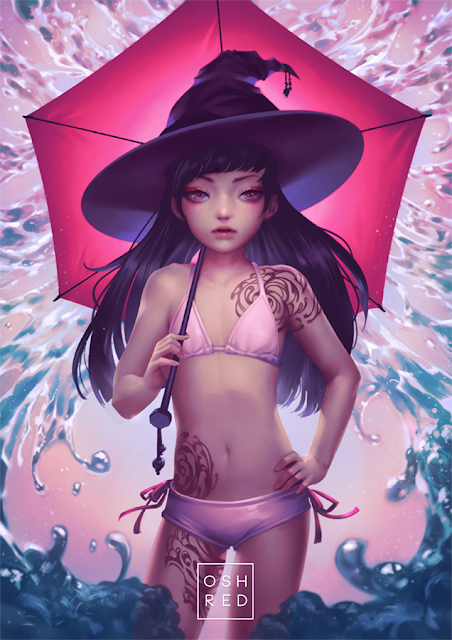Corey Brickley Study
Value
When we break this image down into its separate components of value we can clearly see from the get go that he uses a dark nine for the right side of the shadow that she casts and he connects this dark shadow to the other shadows stretch away from her to the right, and below her. He counters this with a strong white shapes that go all the way to a number 1 for her left side. The value of the snakes although at first glance look lighter than you would expect he actually uses these red snakes to connect the medium values of the grass on her left to the medium dark shadows on her dress and finally to the darkest shadows to her right. Its interesting to notice that the white shapes are the ones broken up but you could follow the gray and dark shapes throughout the entire piece.
This is something I've noticed since I started doing these analysis articles again, that I never noticed before: Generally the blacks and grays can be connected with lower grays acting as a bridge of sorts between the two. The white shapes of her dress and her face and how these whiter shapes are so broken up gives a nice contrast to the rest of the values making her our obvious focal point.
Composition and focal point:
The focal point here is very straight forward and this reiterates how simple yet opowerful a composition can be when using very clear ways of driving the eye to a focal point. All of the snakes in this piece all move to point towards her and her face, her face contrasts in that it is the only other part of this illustration that has red in it that isnt a snake, so its consistent with the rest of the immage. We also notice that she lies in a almost christ like gesture which i thought was pretty interesting. The decision to have one leg up and one leg down creates the shadow shapes that make her dress pop out sharp like a knife from the rest of the composition.
Texture
We notice here that the grass has a lot of texture but what is not immediately noticeable is that when the grass breaks up and we see darker spots it is generally because it is connected to or close to other darker shadow shapes. He still leaves the grass together for the most part and only breaks it up to show some variety.
Color
Nice contrast between red and green, and he uses a sickly yellow color for the whiter parts of the piece.
On the right side we see this transition from green gon into the blues since this gives us our cooler blue colors on this side. When we get back to look at the values we can note a couple of different things. For one that each color has its own value structure, I've attached a comparison of value to color below from the Youtube artist Sycra to show what I mean:
Nice contrast between red and green, and he uses a sickly yellow color for the whiter parts of the piece.
On the right side we see this transition from green gon into the blues since this gives us our cooler blue colors on this side. When we get back to look at the values we can note a couple of different things. For one that each color has its own value structure, I've attached a comparison of value to color below from the Youtube artist Sycra to show what I mean:
Here we can see that colors only really exist in a value range. This gives us a clue that perhaps the reason why there is blue on the right side of the image is not just for the sake of adding blue but its actually to darken this side of the image. This is the core of understanding color, that it is not really about the color you pick but about where the values should fall, so if we think of it this way we can see the color is broken down into yellow for the values ranging in the lightest parts of the image, with the greens and reds making up the range of the gray tones in varying degrees of saturation and a darker blue for the dark shadows and the grass on the right side.
What we have then is a very well balanced piece. We see both a light and a dark side not necessarily symmetrical but they balance each other well.





Comments
Post a Comment